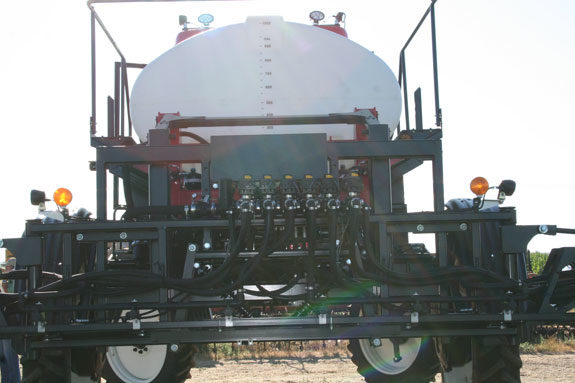Erdal Ozkan, an agricultural engineer and spraying technology expert with Ohio State University Extension and the Ohio Agricultural Research and Development Center (OARDC), recommends following 10 common-sense tips that will help farmers improve sprayer performance:
1. Calibrate. Applying chemicals with a sprayer that is not calibrated and operated accurately could cause insufficient weed, insect or disease control, which can lead to reduced yields, Ozkan said. Check the gallon-per-acre application rate of the sprayer.
This can only be determined by a thorough calibration. Use clean water while calibrating to reduce the risk of contact with chemicals. Read OSU Extension Publication AEX-520 for an easy calibration method.
2. Mind the nozzle. How the chemical is deposited on the target is as important as the amount applied. Know what kind of nozzles are on your sprayer and whether or not their patterns need to be overlapped for complete coverage.
Make sure the nozzles are not partially clogged. Clogging will not only change the flow rate; it will also change the spray pattern. Never use a pin, knife or any other metal object to unclog nozzles.
3. Avoid streaks. In addition to clogging, other factors such as nozzle tips with different fan angles on the boom and uneven boom height are the most common causes of non-uniform spray patterns.
They can all cause streaks of untreated areas that result in insufficient pest control and economic loss.
4. Check the boom. Setting the proper boom height for a given nozzle spacing is extremely important in achieving proper overlapping.
Conventional flat-fan nozzles require 30 percent to 50 percent overlapping of adjacent spray patterns. Check catalogs for specific recommendations for different nozzles.
5. Know actual travel speed and keep it as steady as possible. Increasing the speed by 20 percent may let you cover the field more quickly, but it also cuts the application rate by 20 percent.
Similarly, a reduction of speed by 20 percent causes an over-application of pesticide by 20 percent – an unnecessary waste of pesticides and money.
6. Pay attention to spray pressure. Variations in pressure will cause changes in application rate, droplet size and spray pattern.
At very low pressures, the spray angle will be noticeably narrowed, causing insufficient overlap between nozzle patterns and streaks of untreated areas. High pressure will increase the number of drift-prone droplets.
7. Avoid the dreadful drift. Spray drift wastes more chemicals than anything else. Don't spray when the wind speed is likely to cause drift. Don't take the risk of getting sued by your neighbors because of drift damage to their fields.
Keep the spray pressure low if it is practical to do so, or replace conventional nozzles with low-drift nozzles.
Use other drift-reduction strategies: keep the boom close to the target, use drift-retardant adjuvants, and spray in early morning and late afternoon when drift potential is less.
8. Be prepared. Carry extra nozzles, washers, other spare parts and tools to repair simple problems quickly in the field.
9. Calibrate again. Keep calibrating your sprayer periodically during the spraying season so it stays at peak performance. One calibration per season is never enough.
For example, when switching fields, ground conditions (tilled, firm, grassy) will affect travel speed, which directly affects gallon-per-acre application rate.
10. Be safe. Read the chemical and equipment instructions and follow them. Wear protective clothing, rubber gloves and respirators when calibrating the sprayer, doing the actual spraying, and cleaning the equipment. FG
—Excerpts from Ag Answers newsletter, April 2011
Photo by Lynn Olsen.













